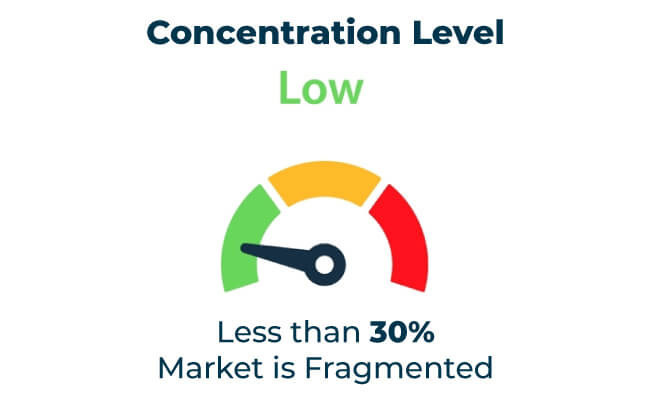The retail paper bag market is growing rapidly. The increasing demand for sustainable and environmentally friendly packaging is the leading factor in the growth of the market.
Market leaders like Mondi, Smurfit Kappa, and International Paper lead this shift by offering innovative solutions that are ecologically friendly, catering to diverse retail applications. The market is expected to grow at 4.3% CAGR and reach about USD 2.8 billion by 2035. Consumer awareness related to sustainability, along with initiatives from the government to reduce plastic waste, contribute to the market's growth.
| Metric | Value |
|---|---|
| Market Size 2035 | USD 2.8 billion |
| CAGR (2025 to 2035) | 4.3% |
Strengths
Weaknesses
Global Market Share & Industry Share (%)
| Category | Market Share (%) |
|---|---|
| Top 3 Players (Mondi, Smurfit Kappa, International Paper) | 16% |
| Rest of Top 5 Players | 06% |
| Next 5 of Top 10 Players | 07% |
Type of Player & Industry Share (%)2025
| Player Tier | Industry Share (%) |
|---|---|
| Top 10 Players | 29% |
| Next 20 Players | 45% |
| Remaining Players | 26% |

Year-over-Year Leaders
The retail paper bag market aligns with global efforts to reduce plastic waste and encourage sustainable practices.
Key Sustainability Phenomena
Regional Compliance
Increasing global demand for eco-friendly retail packaging presents enormous export opportunities. Key regions in Asia-Pacific, Africa, and South America have taken up the usage of retail paper bags.
The retail paper bag market will expand as sustainability continues to drive consumer and regulatory priorities. Companies that invest in eco-friendly materials and innovative manufacturing will determine the future of the industry.
| Tier | Key Companies |
|---|---|
| Tier 1 | Mondi, Smurfit Kappa, International Paper |
| Tier 2 | DS Smith, WestRock |
| Tier 3 | Stora Enso, Pratt Industries |
The retail paper bag market will continue to expand, focusing on sustainability and innovation. Companies focused on advanced materials, cost efficiency, and green practices will define the future of this industry.
Rising demand for sustainable packaging and government regulations are key drivers.
The market is expected to grow at a CAGR of 4.3%, reaching USD2.8 billion by 2035.
Mondi, Smurfit Kappa, and International Paper are among the top players.
The top 10 players hold approximately 85% of the global market share.






Full Research Suite comprises of:
Market outlook & trends analysis
Interviews & case studies
Strategic recommendations
Vendor profiles & capabilities analysis
5-year forecasts
8 regions and 60+ country-level data splits
Market segment data splits
12 months of continuous data updates
DELIVERED AS:
PDF EXCEL ONLINE
Retail Glass Packaging Market Size and Share Forecast Outlook 2025 to 2035
Retail E-Commerce Packaging Market Size and Share Forecast Outlook 2025 to 2035
Retail Automation Market Size and Share Forecast Outlook 2025 to 2035
Retail Clinics Market Analysis – Size, Share, and Forecast Outlook 2025 to 2035
Retail Logistics Market Size and Share Forecast Outlook 2025 to 2035
Retail Displays Market Size and Share Forecast Outlook 2025 to 2035
Retail Sales of Legume Snacks in the UK Analysis - Size, Share & Forecast 2025 to 2035
Retail Sales of Kvass in Russia and CIS countries Analysis - Size, Share & Forecast 2025 to 2035
Retail Sales of Layered Verrine‑Style Desserts in France Analysis - Size, Share & Forecast 2025 to 2035
US Convenience Confectionery Retail Sales Analysis - Size, Share & Forecast 2025 to 2035
Retail Sales of Bergamot from Calabria in Italy Analysis - Size, Share & Forecast 2025 to 2035
Retail Sourcing And Procurement Market Size and Share Forecast Outlook 2025 to 2035
Retail Colocation Market Size and Share Forecast Outlook 2025 to 2035
Retail Warehouse Management Systems Market Size and Share Forecast Outlook 2025 to 2035
Retail Printers Market Growth - Trends & Forecast 2025 to 2035
Retail Vending Machine Market Analysis - Size, Share, and Forecast 2025 to 2035
Retail Analytics Market Analysis by Solution, Function, Enterprise Size, Deployment Model, Field Crowdsourcing, and Region Through 2035
Retail Printers and Consumables Market Growth - Trends & Forecast 2025 to 2035
Retail Signage Market
Retail Digital Signage Market

Thank you!
You will receive an email from our Business Development Manager. Please be sure to check your SPAM/JUNK folder too.
Chat With
MaRIA